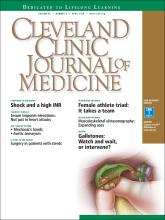
New laboratory tests seem to go through a life cycle. At first, some are used mainly by subspecialists, who became aware of them through early clinical trials or studies presented at specialty meetings. The general medical community adopts their use after noting that they are being ordered by consultants or were used in important published studies.
Sometimes, a new test is significantly better than the older ones, and clinical pathologists and subspecialists encourage us to use it. Sometimes, a new test may represent a breakthrough in the understanding of the pathophysiology of a disease, and its use is promoted by clinicians with special interest in that disease. Testing for serum troponin, as discussed by Sebastian et al in this issue of the Journal (page 274), is an example primarily of the first situation, while testing for antineutrophil cytoplasmic antibodies (ANCA) and immunoglobulin G4 are two of many examples of the second.
Once a test comes into widespread use, its accuracy and reproducibility can be problematic. The assay itself may have inherent weaknesses, or techniques may not be standardized among different laboratories; think about diagnosis of the antiphospholipid antibody syndrome. Standardization of laboratory techniques can often be achieved. For troponin, this remains a problem, though small, for patients whose serum is tested in different laboratories or for clinicians trying to directly compare different clinical trial results; but it doesn’t affect clinical decision-making when longitudinally following a specific patient through a single hospitalization.
In its mature years, as a useful novel test becomes widely used, it may alter how we view the management and pathophysiology of a disease. For example, in the days when postoperative myocardial infarction (MI) was diagnosed by electrocardiographic changes and then by elevations in creatine kinase (CK) and alterations in the ratio of aspartate aminotransferase (AST) to alanine aminotransferase (ALT), the peak in MI incidence was thought to occur several days after surgery. With the advent of CK iso-enzymes and then cardiac myocyte-derived troponin, it became apparent that perioperative myocardial injury occurs more in a time frame of hours after surgery. Laboratory data dovetailed with pathologic and angiographic data indicating that the mechanism of MI in the perioperative setting for many patients is different than in “native” MI. As newer, highly sensitive troponin assays are introduced, they may further our understanding of mechanisms of cardiac myocyte membrane injury and tissue necrosis, and may further clarify (or blur) the distinction between the two.
Often, a widely used test is ordered in clinical situations that were not specifically evaluated during initial studies of the test and early use by specialists. Case reports of unexpected results then appear in the literature. Intrinsic test performance may occasionally be influenced in unanticipated ways (eg, rheumatoid factor can affect test results of some troponin and cryptococcal antigen assays), but more frequently it is the definition of “normal” and interpretation of the test results in specific clinical conditions that are affected. For example, troponin levels are higher in patients with chronic kidney disease and severe sepsis. These elevations may be explained by decreased renal clearance of detected fragments of troponin but may also reflect subclinical myocardial injury related to circulating cytokines or other factors. Elevation of troponins in patients with these and other conditions has correlated with poorer outcomes. Thus, in some settings, elevated circulating troponin has greater prognostic than diagnostic significance.
Recognizing imperfect test specificity (false-positive results) is critical when using a test in complex clinical situations. This can be especially challenging when using indirect serologic tests: consider the many reasons for “false-positive” antinuclear antibody, ANCA, and rheumatoid factor test results. But it can also be a challenge when trying to use a targeted test like troponin to distinguish between MI, sepsis, and pulmonary embolism as the cause of acute hypotension.
Many routinely ordered tests require more nuanced interpretation than simply checking the value against the defined laboratory “normal.” These nuances may be well known to those who order the test often or to specialists, but not to all. Familiarity with tests can also result in a subliminal assumption that we fully understand their characteristics and can lead to misinterpretation of results. There are forgotten critical concepts about tests that are ordered extremely commonly: eg, AST and ALT do not come only from the liver and do not reflect “liver function.” Liver biopsy is unlikely to provide the explanation for a myositis patient’s sense of weakness, even if the aminotransferase levels are elevated in the several-hundred range.
A CALL FOR MANUSCRIPTS
I invite you to draw on your personal experience and the literature and submit short manuscripts that address the nuanced interpretation, limitations, and cost of specific laboratory tests. As with all submissions, these will undergo peer review for content accuracy, as well as relevancy and utility for our core readership before being considered for publication.
- Copyright © 2018 The Cleveland Clinic Foundation. All Rights Reserved.






